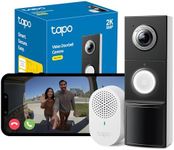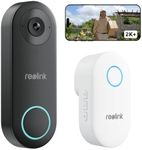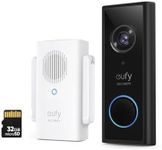Buying Guide for the Best Doorbell Cameras
When choosing a doorbell camera, it's important to consider the specific features that will best meet your needs for security, convenience, and compatibility with your home setup. Doorbell cameras can offer peace of mind by allowing you to see who is at your door, even when you're not home. To make the best choice, think about where you will install the camera, what kind of connectivity you have, and what features are most important to you, such as video quality, field of view, and smart home integration.Video QualityVideo quality is crucial because it determines how clear and detailed the footage from your doorbell camera will be. Higher resolution cameras, such as those offering 1080p or even 4K, provide clearer images, which can be important for identifying faces or details. However, higher resolution requires more bandwidth and storage. If you have a fast internet connection and ample storage, a higher resolution camera might be ideal. For those with limited bandwidth, a 720p camera might suffice, offering a balance between quality and data usage.
Field of ViewThe field of view refers to how much area the camera can capture. A wider field of view, such as 160 degrees or more, allows you to see more of your porch and the surrounding area, which can be beneficial for spotting visitors or packages. If your doorbell is positioned in a way that requires a broad view, opt for a wider field of view. Conversely, if your entryway is narrow or you only need to see directly in front of the door, a narrower field of view might be sufficient.
Night VisionNight vision is important for capturing clear video footage in low-light or dark conditions. This feature ensures that you can see who is at your door even at night. Infrared night vision is common and effective, but some cameras offer color night vision, which can provide more detail. If you expect to use the camera frequently at night or live in a poorly lit area, prioritize a camera with strong night vision capabilities.
Two-Way AudioTwo-way audio allows you to communicate with visitors through the doorbell camera. This feature is useful for speaking to delivery personnel or guests without opening the door. It can also be a deterrent for unwanted visitors. If you value the ability to interact with people at your door remotely, ensure the camera has clear audio quality and minimal delay.
Motion DetectionMotion detection alerts you when someone approaches your door, which can be a key security feature. Some cameras offer customizable motion zones and sensitivity settings, allowing you to tailor alerts to your needs and reduce false alarms. If you live in a busy area, look for a camera with advanced motion detection features to avoid constant notifications.
Smart Home IntegrationSmart home integration allows your doorbell camera to work with other smart devices, such as smart locks or voice assistants. This can enhance convenience and security, enabling features like voice commands or automated routines. If you already have a smart home ecosystem, choose a doorbell camera that is compatible with your existing devices to ensure seamless integration.
Power SourceDoorbell cameras can be powered by batteries or wired connections. Battery-powered models offer flexibility in installation but require regular recharging or battery replacement. Wired models provide continuous power but may require professional installation. Consider your willingness to manage battery life versus the convenience of a wired setup when choosing the power source.
Storage OptionsStorage options determine how video footage is saved and accessed. Some cameras offer cloud storage, which provides easy access from anywhere but may require a subscription. Others use local storage, such as a microSD card, which can be more cost-effective but limits access to footage. Decide whether you prefer the convenience of cloud storage or the control of local storage based on your access needs and privacy concerns.
















